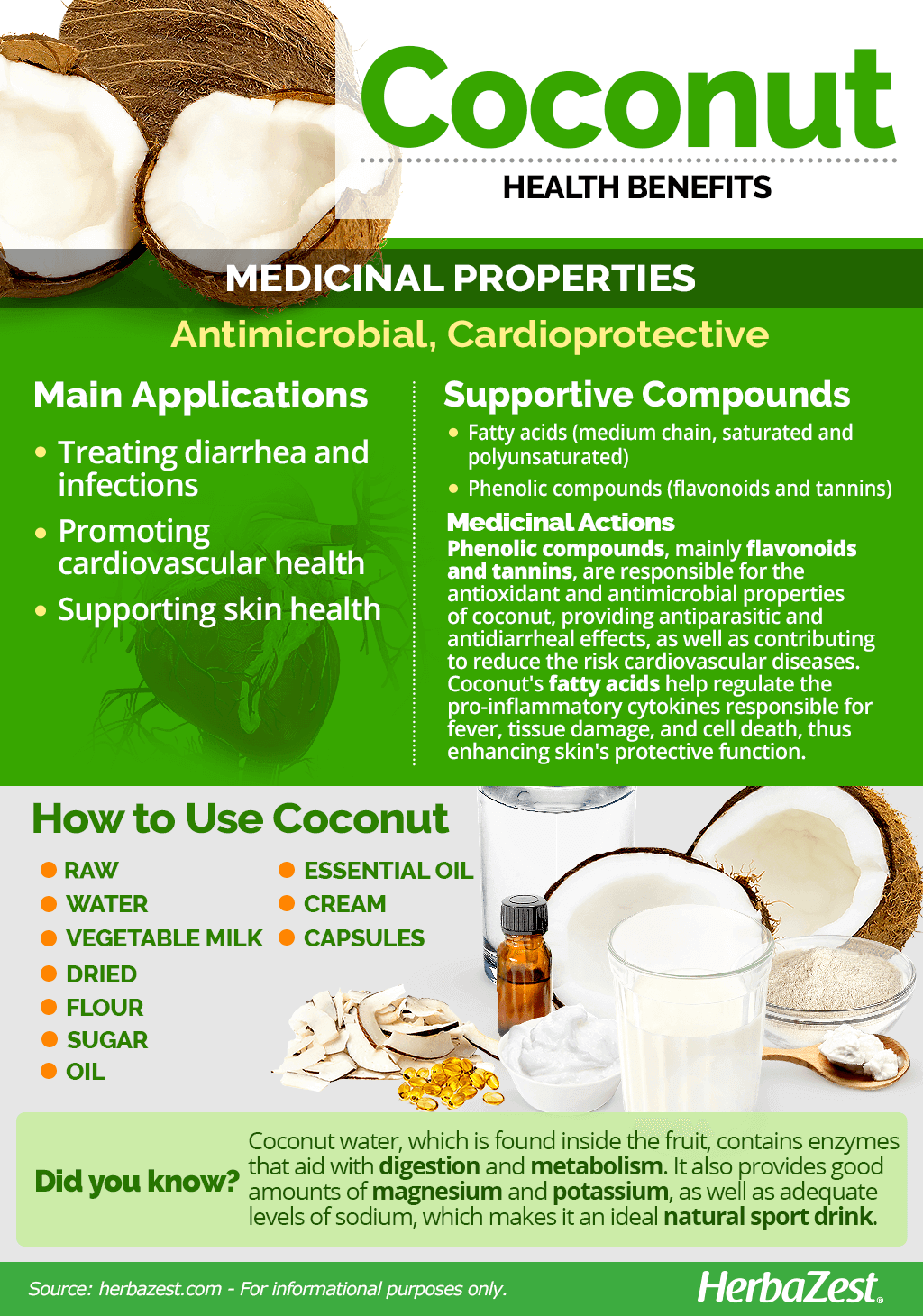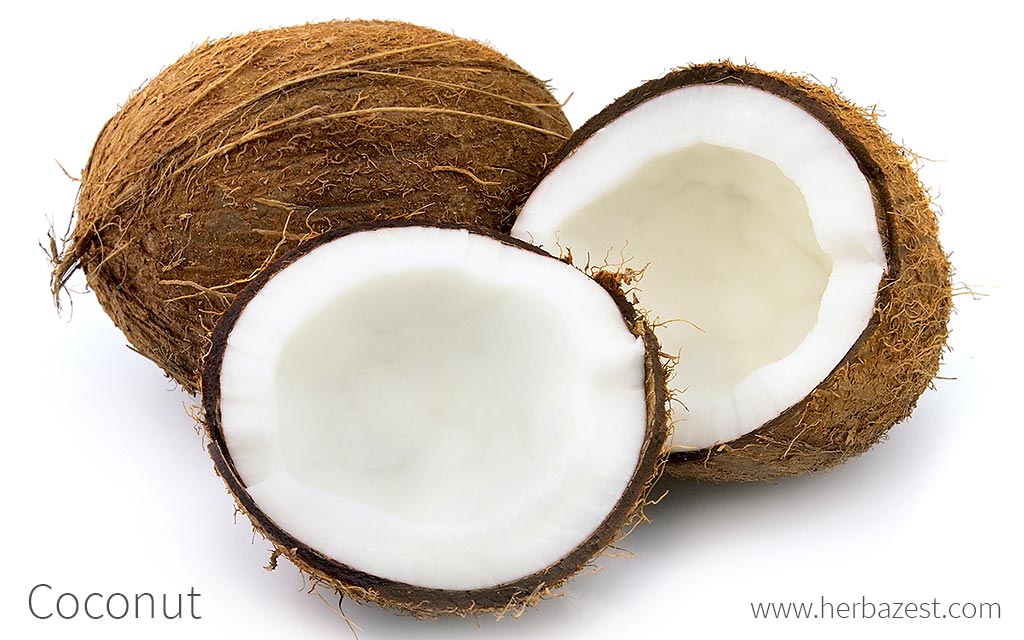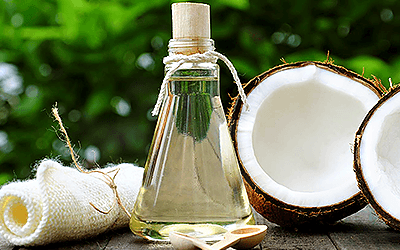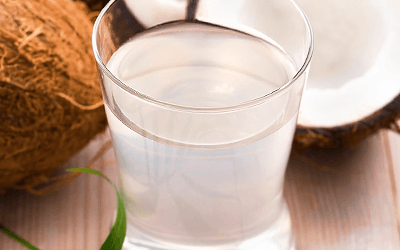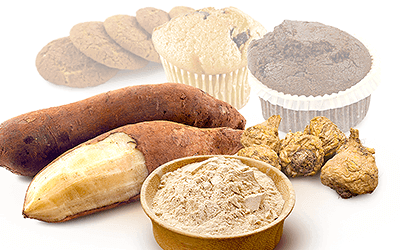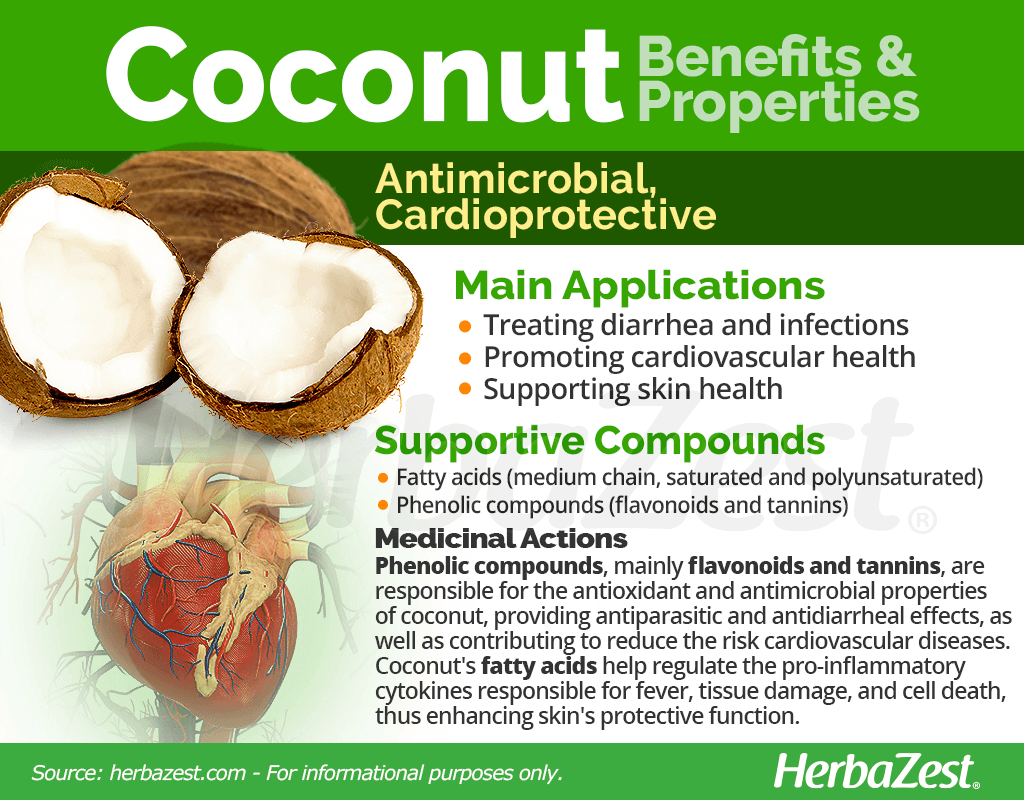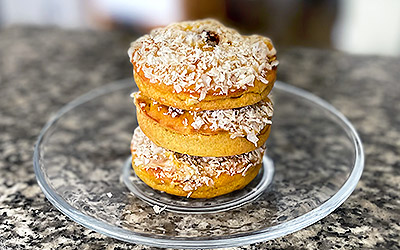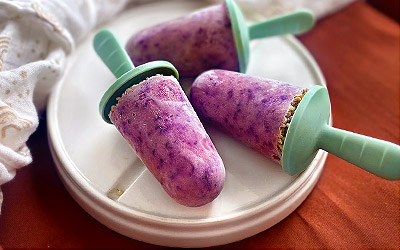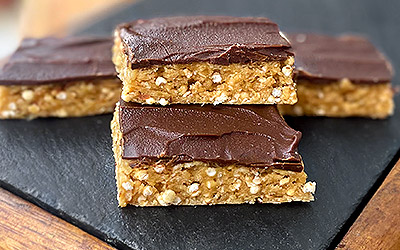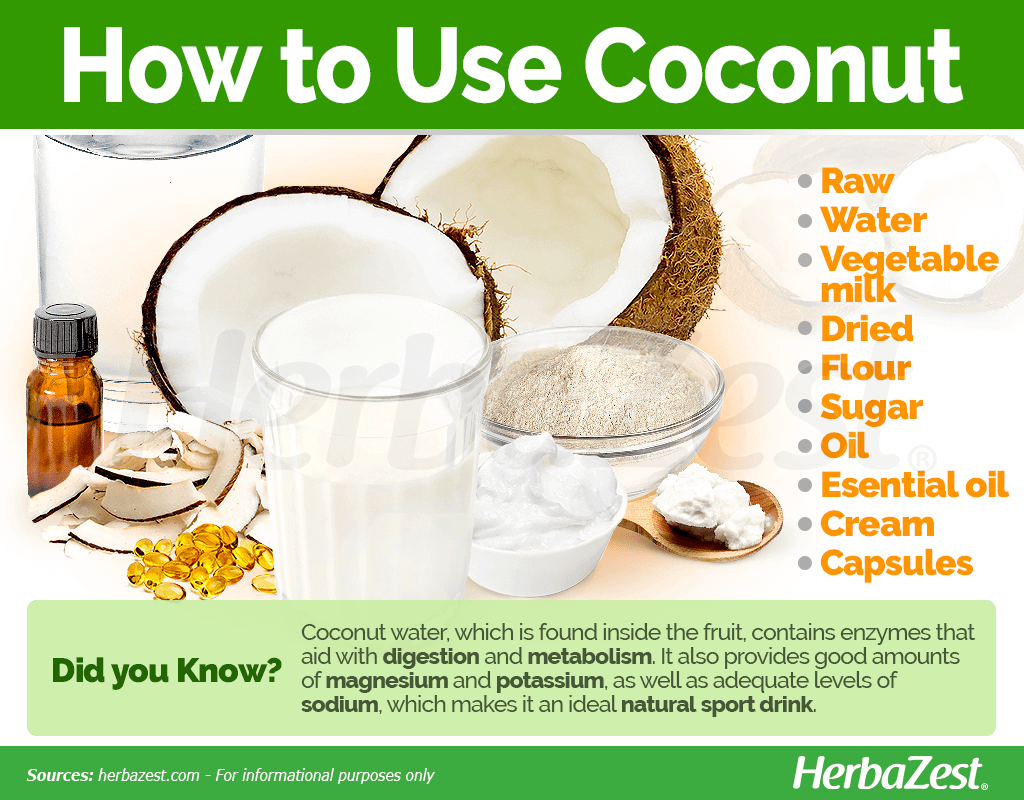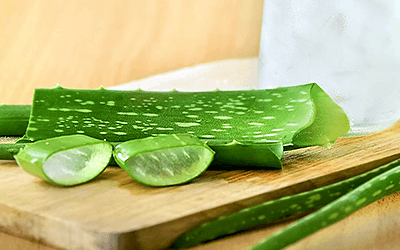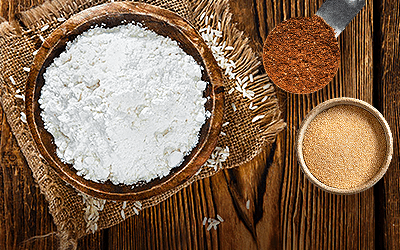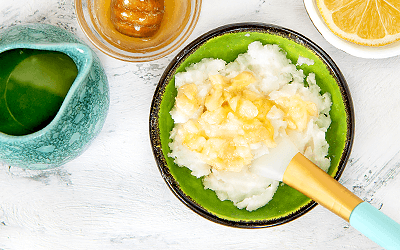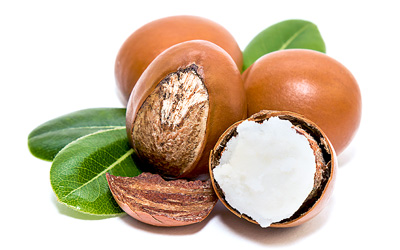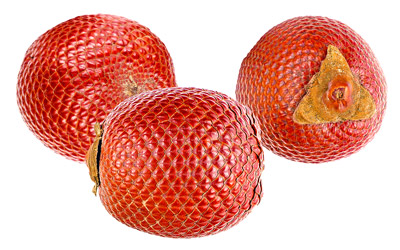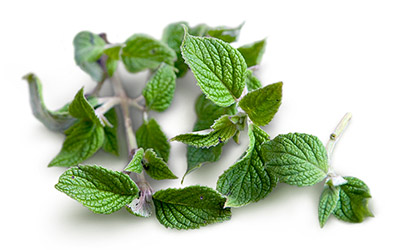Commonly called “coconut tree,” the coconut palm is really a tall, woody herb, and it is thought to have originated in the Southeast Asia and the Pacific islands of Melanesia. However, coconuts have been transported by the ocean currents to different countries and have thrived in tropical and subtropical regions across the globe, becoming a staple to many aboriginal cultures.
Coconut Medicinal Properties
- Medicinal action Antimicrobial, Cardioprotective
- Key constituents Saturated and polyunsaturated fatty acids, phenolic compounds
- Ways to use Capsules, Liquid extracts, Food, Freshly ground, Juiced, Powder, Ointment, Essential oil, Dried
- Medicinal rating (4) Very useful plant
- Safety ranking Safe
Health Benefits of Coconut
While coconut has become highly popular for a myriad of touted benefits, evidence remains controversial and most commercial claims about it have not been backed up by scientific research. However, long-standing traditional uses and recent evidence suggest that coconut properties can be useful for:
Treating diarrhea and infections. Coconut milk and water have been traditionally used for treating fever and diarrhea, while virgin coconut oil has proven very effective against a variety of viruses, bacteria, and parasites.
Promoting cardiovascular health. Some studies suggest that virgin coconut oil's antioxidant properties may help reduce vascular inflammation and blood pressure, whereas coconut water has been shown to reduce cholesterol and triglycerides.
Supporting skin health. Virgin coconut oil is rich in antioxidant compounds and fatty acids, all of which work to keep the skin nourished and moisturized, delaying and smoothing visible signs of aging.
Additionally, studies have focused on other potential coconut benefits, such as reducing osteoporosis and treating diabetes; however, further investigation is necessary to corroborate these preliminary findings.
How It Works
Virgin coconut oil is obtained from the fresh, mature kernel of the coconut, without the use of heat and chemical refining processes. This method of production preserves a great deal of biologically active substances, including vitamins, minerals, and antioxidants. However, manufactured coconut oil is refined, bleached, and deodorized, losing most of its health benefits during this process, except for a high smoke point, which makes it popular for culinary uses.
All parts of coconut provide bioactive compounds that are beneficial for human health. The coconut husk (mesocarp), flesh, and oil are full of phenolic compounds, mainly flavonoids and tannins. While the first have antioxidant and antimicrobial properties, the later provide astringent and antiparasitic effects. These medicinal actions may explain the traditional use of extracts and decoctions of coconut husk as well as coconut oil and milk for treating many infectious diseases, particularly fever, stomach aches, diarrhea, and intestinal parasites.
Virgin coconut oil is also rich in medium-chain fatty acids (MCFAs), mainly caprylic, caproic, capric and lauric acid, all of which are ideal for baking, deep frying, and stir frying since they resist high temperatures without getting oxidized. While these qualities have contributed to the popularity of coconut oil for culinary uses, studies suggest that coconut fatty acids are also beneficial for cardiovascular health. MCFAs are quickly absorbed as a source of energy, which prevents them from participating in cholesterol metabolism. Additionally, virgin coconut oil contains saturated (myristic, palmitic, and stearic acids) and polyunsaturated fatty acids (omega-3), which makes it a healthy choice.
The phenolic compounds in coconut (particularly in virgin coconut oil) are responsible for its anti-inflammatory and antioxidant effects, which contribute to reducing the risk cardiovascular diseases by preventing the accumulation of arterial plaque that eventually leads to hypertension and atherosclerosis. Additionally, virgin coconut oil has been found to inhibit the formation of blood clots, thus reducing the risk of thrombosis.
The topical application of virgin coconut oil has been shown to improve the symptoms of skin disorders by moisturizing and soothing its layers as well as protecting the skin from solar damage. Coconut's fatty acids play a role in the regulation of pro-inflammatory cytokines responsible for inflammation, fever, tissue damage, and cell death, thus enhancing skin's protective function, the first line of defense against injuries and microbial pathogens.
Coconut water, which is found inside the nut, contains compounds such as cytokinin, phosphatase, and catalase - enzymes that aid with digestion and metabolism.
Additionally, monolaurin is a monoglyceride derived from lauric acid, which makes up nearly 50% of coconut's fat content and has been revealed as a major antimicrobial, antiviral, and antifungal agent. Monolaurin has been shown to penetrate and dissolve the membrane of various bacterial strains, such as Propionibacterium acnes, Staphylococcus aureus, Staphylococcus epidermidis, Pseudomonas aeruginosa, Escherichia coli, Proteus vulgaris, and Bacillus subtilis.
THE MOISTURIZING AND ANTIMICROBIAL PROPERTIES OF COCONUT OIL ARE HIGHLY VALUED IN THE COSMETIC INDUSTRY, WHERE IT IS USED IN A VARIETY OF SKIN CARE PRODUCTS.
Other herbs that are popular for treating infections and diarrhea are tea plant, Oregon grape, and raspberry. On the other hand, avocado, chia, and walnuts are beneficial for heart health, whereas aloe, jojoba, and neem are preferred for soothing the skin and treating dermatological conditions.
Coconut Side Effects
While not proven by scientific research, coconut oil could lead to weight gain if consumed in high amounts because of its fat content. Pregnant and breastfeeding women need not worry about coconut oil when used in moderate amounts.
Cautions
No conditions exist in which the consumption of coconut may interfere with medications or other substances. However, in spite of its many health benefits, it remains a fact that coconut oil is about 90% saturated fat, which is a higher percentage than butter (about 64% saturated fat), beef fat (40%), or even lard (also 40%). As such, it is advised to use it sparingly in order to maintain healthy levels of cholesterol and triglycerides.
Though allergic reactions to coconut are relatively rare, some people may experience skin rash from topical applications and stomach ache from direct ingestion.
People allergic to peanut or tree nuts will not necessarily be sensitive to coconut.
Coconut Nutrition
Coconut water is also a good source of some essential nutrients. It is low in calories and provides good amounts of magnesium and potassium as well as adequate levels of sodium, which makes it an ideal natural sport drink. Coconut water also contains fair levels of B-complex vitamins as well as vitamin C (ascorbic acid).
Coconut's fleshy pulp is a great source of energy and provides high levels of fatty acids, which include saturated and polyunsaturated fats, both necessary to metabolic functions. Coconut meat is also low in carbohydrates and high in dietary fiber, which contributes to improving digestion and sugar metabolism.
With all the buzz about coconut oil, it is worth remembering that the firm pulp of coconut offers impressive amounts of minerals, mainly copper and manganese, both of which are crucial for blood cells regeneration and bone strength as well as brain health. Moreover, manganese is essential for blood clotting, sex hormones, and the formation of connective tissue.
Coconut also provides good levels of iron for proper blood oxygenation and transport and selenium, which is an essential nutrient that helps prevent cellular damage and plays an important role in fertility, thyroid metabolism, and immunity.
The nutritional value of fresh coconut pulp is rounded by adequate amounts of B-complex vitamins, mainly B1 (thiamin), B5 (panthotenic acid), and B9 (folate), all necessary for the conversion of carbohydrates into glucose, which is used by the body to produce energy.
100 grams of fresh coconut meat provide 354 calories as well as 7% and 36% of the recommended daily value (DV) for protein and dietary fiber, respectively.
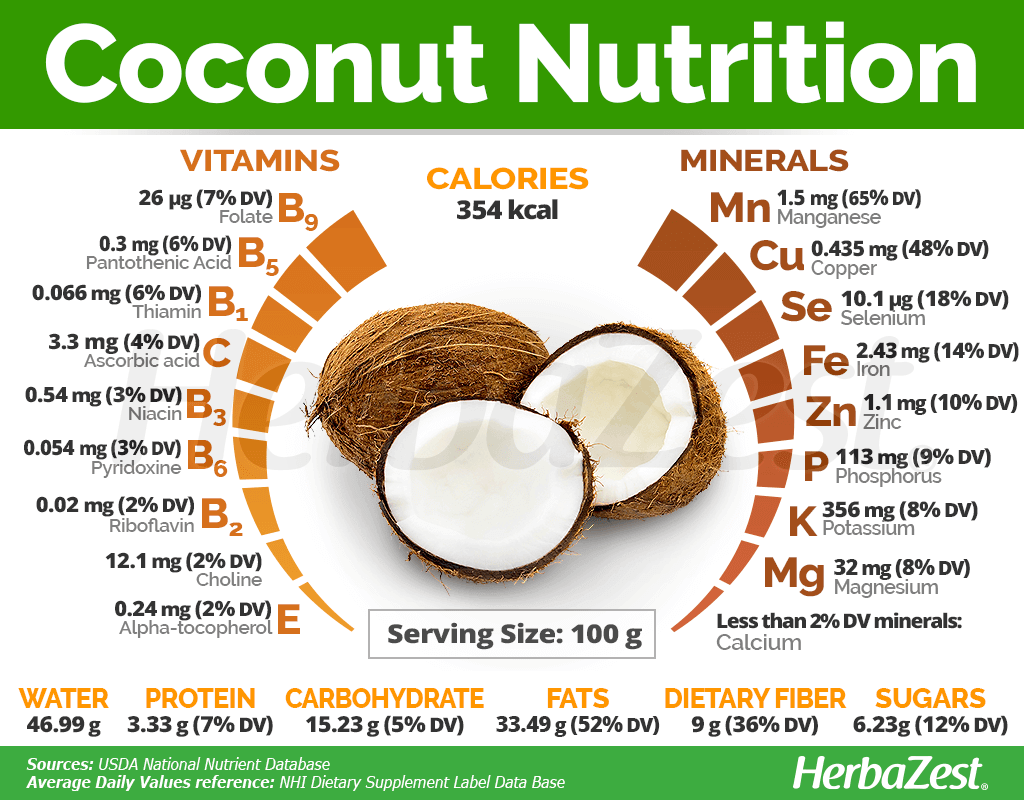
How to Consume Coconut
- Edible parts Fruit
- Edible uses Flavoring, Beverage, Sweetener
- Taste Sweet
Due to its many uses, the coconut palm has been called "the tree of life" in the many countries where it grows. However, the most economically important part of this tropical palm is its hard fruit, or seed, which encases a thick layer of edible flesh and water at its center. In this natural state, coconuts are a staple of coastal regions; however, a number of other natural and supplementary forms can be obtained from coconut and are availed around the world.
Natural Forms
- Did you know?
Coconut milk is composed by equal parts of pulp and water, whereas coconut cream contains approximately four times more pulp and shouldn't be mistaken for cream of coconut, which is intended to be used for cocktails and desserts, and lacks nutritional value, besides being high in fat and sugar.
Raw. For centuries, this has been the most popular way of consuming coconut, while enjoying its mildly sweet flavor, high content of dietary fiber, and its nutritional and medicinal benefits.
Water. Coconut water is not only a refreshing beverage, but also a good source of minerals and antioxidant compounds. It is commonly used as an alternative to commercial hydrating sports drinks as it contains plenty of electrolytes and potassium.
Vegetable milk. Fleshy coconut pulp is grated and squeezed to obtain a creamy juice that provides fatty acids, vitamins, and minerals. Coconut milk can be used in smoothies as well as in both sweet and savory dishes. It is a healthy non-dairy alternative for vegans or those with some degree of lactose intolerance. Coconut cream is the same as coconut milk, but with a lower water content.
Dried. The desiccated pulp of coconut, either grated, in flakes, or in small pieces, can be eaten as a healthy snack for extra energy or be used in a variety of desserts.
Flour. The dried and pulverized pulp of coconut is rich in dietary fiber and provides not only essential nutrients, but also high amounts of insoluble fiber. It is commonly used for baking.
Sugar. Coconut palm sugar (obtained from the flower of the coconut plant) is getting attention as a "healthy sugar." While it is true that it provides some minerals (calcium, iron, potassium, and zinc), coconut palm sugar is still high in calories, as much as regular refined sugar. As such, it should be consumed in moderation.
Herbal Remedies & Supplements
Oil. Depending on the method of extraction, coconut oil may be labeled as virgin, refined, or hydrogenated. Virgin coconut oil is considered healthy and nutrient-rich, whereas refined coconut oil is widely popular for cooking.
Essential oil. Coconut essential oil concentrates the highest levels of lauric and myristic acids. It can be used for relieving eczema and irritations as well as for moisturizing hair and skin, while also protecting the body from UV radiation.
Cream. Coconut oil is used to produce cosmetic creams and lotions to moisturize the skin. Topical coconut creams are touted to have anti-aging effects.
Capsules. Softgels containing coconut oil are popular for nourishing hair and skin as well as for energy and weight management.
DUE TO THE CHEMICAL PROCESSES USED TO OBTAIN IT, HYDROGENATED COCONUT OIL IS NOT RECOMMENDED. ADVERSE HEALTH EFFECTS HAVE BEEN ASSOCIATED WITH TRANS AND SATURATED FATS.
Growing
- Life cycle Perennial
- Harvested parts Fruit
- Light requirements Full sun
- Soil Well-drained
- Soil pH 5.1 – 5.5 (Strongly acidic), 5.6 – 6.0 (Moderately acidic), 6.1 – 6.5 (Slightly acidic), 6.6 – 7.3 (Neutral), 7.4 – 7.8 (Slightly alkaline)
- Growing habitat Coastal regions, Tropical regions, Warm climates
- Pre-germination seed treatment Soaking
- Growing time 6-10 years
Popularly touted as a tree, coconut is really a tropical palm (Cocos nucifera), a tall, woody herb that that grows naturally in warm climates around the world. In a suitable environment, the coconut tree can be successfully grown for ornamental and nutritional purposes.
Growing Guidelines
Cocos nucifera palms can adapt easily to different soils as long as they are well drained and with a pH of 5.0-8.0.
Ideal temperatures for growing coconut are within the range of 70-80°F (21-27°C) and high levels of humidity.
In order to plant the coconut tree, all one needs is a coconut that still has its husk. Soak it in water for two to three days.
It is highly important to make sure the nut is planted in soil that drains well. It should be placed in a container at least 12 inches (30 cm) deep so the roots have room to grow.
The coconut should be planted point side down, with one-third of the nut staying above the soil. Place the pot in a well-lit and warm location.
Make sure to keep the coconut plant well watered and monitor the drainage.
Coconut trees require regular fertilizer and take at least six years before they produce any fruit.
Additional Information
- Other uses Basketry, Cosmetics, Repellent
Coconut palms are not trees but large, woody herbs that grow to be 100 feet (30 m) tall, with 13 -20 foot-long (4 - 6m) leaves. A full-sized coconut does not appear until the palm is between 6 - 10 years old, and will weigh approximately 3.2 pounds (1.4 kg).
- Classification
The coconut (Cocos nucifera) is said to be the only species in the Cocos genus, which belongs to the Arecaceae, or palm family, a botanical group of perennial plants that gathers over 65 species, collectively known as "palm trees." Coconut is arguably the most economically important species within the Arecaceae family, along with dates (Phoenix dactylifera) and saw palmetto (Serenoa repens), whereas acai (Euterpe oleracea) and aguaje (Mauritia flexuosa) are quickly growing in popularity as tropical species.
Varieties and Subspecies of Coconut
The widespread domestication of coconut palm has led to the development of two distinct varieties: Cocos nucifera var. typica and Cocos nucifera var. nana. The first one, a tall coconut variety, is an hybrid; it has, therefore, been separated into numerous cultivars in order to enhance specific yield characteristics. The latter, a dwarf coconut, is known for germinating and fruiting faster, but is mostly developed for ornamental purposes.
Historical information
Like no other species, the history of the coconut palm is intertwined with the history of human trade and colonization across the tropics. While its exact is still subject of controversy, it is thought that the coconut tree may have originated in the Western Pacific or Eastern Indian Oceans.
The first European records of coconuts are attributed to Marco Polo, who saw them in 1280, when he explored the shores of Indonesia. Over two centuries later, in 1498, the Portuguese explorer Vasco da Gamma reported seeing coconuts in Kenya during his travels trough Africa and the Asian subcontinent (today's India). Around the same time, Christopher Columbus erroneously identified coconut palms when exploring the Caribbean region.
Historical evidence points to Diego Corenco, a former pastor of Cape Verde, as the first traveler that introduced coconuts into the Caribbeans, specifically to Puerto Rico, in 1549. Recent studies of early Spanish records indicate that coconut palm naturally traveled to the tropical parts of America with ancient voyagers or by floating across the ocean with strong currents. However, it wasn't until 1878 that the coconut palm was officially introduced to Florida by Spaniard merchants.
Economic Data
Coconut trees are cultivated in over 90 countries throughout the world and produce an average 62 million tons per year. Due to their growing popularity in the health world and their wide variety of uses, coconuts are in high demand. In 2013, Indonesia was the top coconut producer in the world, putting out 18,300,000 tons. Coconut trees serve as decoration as well and stand as a symbol of sun and relaxation in many tropical parts of the world.
Other Uses
Cosmetic industry. Due to its purported benefits for hair and skin, coconut oil is widely used in personal care products. It is especially common in moisturizers and anti-frizz products. Its scent is also used in candles and air fresheners.
Housing and crafts. In their native lands, all parts of the coconut tree are used for different purposes. The leaves are commonly used for handcrafts, such as baskets, fans, hats, and ornamental headdresses, whereas coconut wood has been traditionally used as a home building material.
Sources
- ASCIA - Australasian Society of Clinical Immunology and Allergy, Coconut allergy
- Brazilian Journal of Medical and Biological Research, Cocos nucifera (L.) (Arecaceae): A phytochemical and pharmacological review, 2015
- Coconut Cures: Preventing and Treating Common Health Problems with Coconut
- Coconut Palm Frond Weaving
- Cook Islands Biodiversity & Natural Heritage, The Origin of the Coconut Palm
- Experimental & Clinical Cardiology, Potential Role of Virgin Coconut Oil in Reducing Cardiovascular Risk Factors, 2014
- Foods & Nutrition Encyclopedia, pp. 439
- Harvard University, Harvard Medical School, Ask the doctor: Coconut oil and health
- International Brazilian Journal of Urology, Prophylactic effect of coconut water (Cocos nucifera L.) on ethylene glycol induced nephrocalcinosis in male wistar rat, 2013
- International Journal of Molecular Sciences, Anti-Inflammatory and Skin Barrier Repair Effects of Topical Application of Some Plant Oils, 2018
- Journal of Basic and Clinical Physiology and Pharmacology, Virgin coconut oil protects against liver damage in albino rats challenged with the anti-folate combination, trimethoprim-sulfamethoxazole, 2014
- Journal of Traditional and Complementary Medicine, In vitro anti-inflammatory and skin protective properties of virgin coconut oil, 2019
- Open Access Scientific Reports, Better than DEET Repellent Compounds Derived from Coconut Oil, 2018
- Postgraduate Medicine, Virgin Coconut Oil and Its Potential Cardioprotective Effects, 2014
- Tropical Food: Chemistry and Nutrition, Volume 2
- University of California, The Origin and the Natural History of the Coconut Palm
- University of Florida, Coconut Oil: A Hearth Healthy Fat?
- Washington University in St. Louis, The origin and dispersal of coconut
- USDA Nutrient Database, Full Report (All Nutrients): 12104, Nuts, coconut meat, raw
- American Journal of Clinical Nutrition, Cholesterol, coconuts, and diet on Polynesian atolls: a natural experiment: the Pukapuka and Tokelau island studies, 1981
- Dermatitis, A randomized double-blind controlled trial comparing extra virgin coconut oil with mineral oil as a moisturizer for mild to moderate xerosis, 2004
- Evidence-based Complementary and Alternative Medicine, Virgin coconut oil supplementation prevents bone loss in osteoporosis rat model, 2012
- The Ecology of Plants
